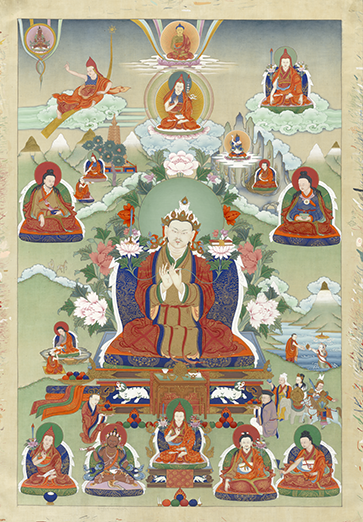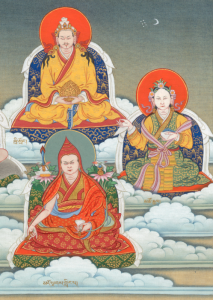Trisong Ladrub Collection
This profound cycle of sādhanas and prayers was revealed by Khyentse Wangpo following a visionary encounter with the great Dharma King of Tibet, Trisong Deutsen, who is referred to here by his secret name, Tsangpa Lhayi Metok, “Divine Brāhma Flower.”

This practice collection is based on Khyentse Wangpo’s visionary encounter with the Dharma king Tsangpa Lhayi Metok, “Divine Brahmā Flower,” the secret name of Trisong Deutsen. These practices present a powerful method for practitioners to receive Trisong Deutsen’s blessings, merge inseparably with the guru as the Dharma king, and attain the wisdom mind of Mañjuśri.
These works belong to Khyentse Wangpo’s Trisong Deutsen treasure cycle, which is included in the Pure Vision section of the Seven Transmissions Compendium (Kabab Dun). In the colophon of the sādhana, Khyentse Wangpo mentions receiving a “small blessing” from the Dharma king, after which he spontaneously composed the practice as it arose in his mind. The description of the Trisong Ladrub tangka includes the story of how Khyentse Wangpo encountered the king in the form of a buddha in the pure land of Padmāvatī. While the sādhana and guru yoga were composed by Khyentse Wangpo himself, the accompanying lineage prayer was written by his subsequent incarnation, Dilgo Khyentse Tashi Paljor.

Trisong Deutsen, who was an emanation of Mañjuśrī, ruled imperial Tibet as the thirty-eighth emperor from 755 to 797 (or perhaps 804). He was the second of Tibet’s three great Buddhist kings (the others being Songtsen Gampo and Tri Ralpachen). During his illustrious reign, Trisong Deutsen invited the great abbot Śāntarakṣita and later Padmasambhava to Tibet from India, and together they established Buddhism as the state religion. The emperor offered his wife, Yeshe Tsogyal, and his entire kingdom to Padmasambhava and became one of his main disciples. As Tibetan Buddhism’s greatest benefactor, Trisong Deutsen oversaw the building of the great temple of Samye, the assembling of Tibet’s first ordained saṅgha, and the translation of the entire Tripiṭaka into Tibetan.
Jamyang Khyentse Wangpo, also a manifestation of Mañjuśrī, was widely known as the prophesied body emanation of Dharma King Trisong Deutsen. According to Khyentse Wangpo’s biography, he was the final, collective embodiment of all of Trisong Deutsen’s numerous emanations during the thousand years that separated them.
The following texts belong to Khyentse Wangpo’s Trisong Ladrub treasure cycle, which are included in the Pure Vision section of the Seven Transmissions Compendium (Kabab Dun):
This is a PDF collection of all the Trisong Ladrub practice texts in one compilation.
Dilgo Khyentse Rinpoche wrote this concise lineage supplication for those who wish to practice the guru sādhana. For the five stanzas of the lineage supplication, Dilgo Khyentse Rinpoche employs an elegant poetic device called anaphora, wherein each line begins with the same word. In this case, the first word of each stanza is repeated at the beginning of the following three lines.
This profound guru sādhana was revealed by Jamyang Khyentse Wangpo following a visionary encounter with Dharma King Trisong Deutsen, who is referred to here by his secret name, Tsangpa Lhayi Metok, “Divine Brahmā Flower.” In the colophon of this text, Khyentse Wangpo mentions receiving a “small blessing” from the great Dharma king, after which he wrote down this sādhana as it arose in his mind. The description of the tangka painting that accompanies this cycle explains that Khyentse Wangpo encountered the king in the form of a buddha in the pure land of Padmāvatī.
In the opening verses of the sādhana, Khyentse Wangpo instructs us to undertake the practice in retreat in a remote location. Practitioners should receive the requisite empowerment, reading transmission, and practical instructions specific to this cycle before beginning the retreat. The sādhana is divided into three parts, with a preparation stage, a main practice, and a conclusion. Each section contains elaborate visualizations and supplications to Mañjuśrī in the form of Dharma King Tsangpa Lhayi Metok, who is experienced outwardly, inwardly, and secretly.
This concise guru yoga was written by Jamyang Khyentse Wangpo as a supplication to the root guru as Mañjuśrī in the form of King Trisong Deutsen. The text opens with a verse of refuge and bodhicitta and continues with an elaborate front visualization of one’s root guru as Mañjuśrī in the form of Dharma King Tsangpa Lhayi Metok. One then recites the root mantra of Mañjuśrī, receives the four empowerments, and merges inseparably with the guru. The text concludes with a dedication to the ultimate awakening of all beings, inseparable from Mañjuśrī.
Dzongsar Khyentse Rinpoche gave the empowerment for the Trisong Ladrub cycle in Sydney in November, 2023, to the Siddhartha’s Intent sangha.
修持资源
钦哲旺波:赤松德赞上师成就法
钦哲愿景·汉译计划现已完成三篇与赤松德赞上师成就法相关的修持文本翻译:
- 传承祈愿文:《法王大梵天花上師成就法之傳承祈請文 · 智慧甘露喜宴》
https://siddharthasintent.s3.ap-southeast-2.amazonaws.com/Resources/Practices/TL/5690.pdf - 简短上师瑜伽:《上師文殊與赤松德贊無別之祈請瑜伽 · 二悉地之車輿》
https://siddharthasintent.s3.ap-southeast-2.amazonaws.com/Resources/Practices/TL/13830.pdf - 长仪轨:《真實文殊法王大梵天花之瑜伽 · 智光增上》
https://siddharthasintent.s3.ap-southeast-2.amazonaws.com/Resources/Practices/TL/5700.pdf
